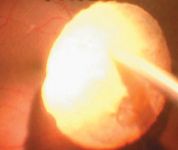Article
FAVIT technique can remove dropped nuclei
A technique for removing lens fragments that have fallen into the vitreous, developed by ophthalmologists in India, is a simple and effective surgical procedure, suggest results of a recent case series. The FAVIT technique was developed in 1999, and the recent series included cases performed with both a 900-μm phaco probe and a new modification, a 700-μm probe.

Key Points

She presented the findings at the annual symposium of the American Society of Cataract and Refractive Surgery.Dr. Amar Agarwal, founder of the eye hospital in Chennai, and colleagues developed the FAVIT technique in 1999 and have continued to modify it.
In her presentation, Dr. Jacob discussed cases performed with both 700- and 900-μm phaco probes; she and her colleagues had previously used only the 900-μm phaco probe and wanted to analyze a series that included procedures performed with the 700-μm microphakonit probe as well.

Instead, the FAVIT technique can be used to remove dropped nuclei safely. This approach is based on appropriate management of the vitreous, followed by removal of the fragments.
Procedure
In the FAVIT technique, an infusion cannula, preferably with chandelier illumination, is fixated through the first port. An endoilluminator is inserted through a second port and a vitrectomy probe through the third. All three ports are through the pars plana.
Next, the surgeon performs a thorough posterior vitrectomy, including the elimination of the vitreous fibers surrounding the retained lens fragment, Dr. Jacob said. Following the vitrectomy, the vitrectomy probe is replaced with a 0.7 mm phaco needle inserted through the same incision. Having a chandelier illumination system would permit the vitrectomy probe to be held in the nondominant hand, thus allowing bimanual vitrectomy. If not, the surgeon holds an endoilluminator in the nondominant hand.

The last step in the procedure is to gradually remove the lens fragment with continuous phacoemulsification in the anterior chamber. No pulsing or chopping should be performed, since these actions might cause small fragments to drop back into the vitreous cavity, Dr. Jacob said. If any excessively large or hard nuclear fragments are present, they may be removed through an enlarged limbal incision.





